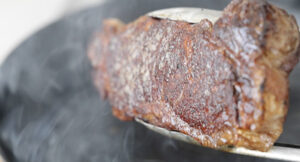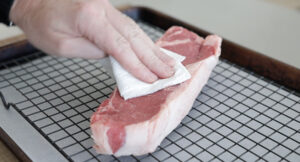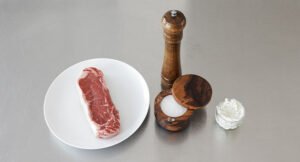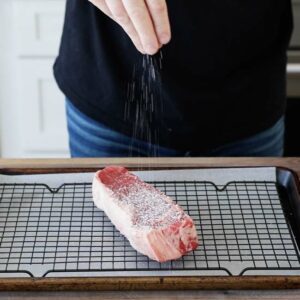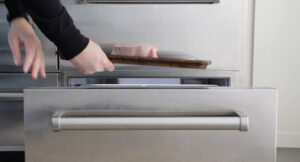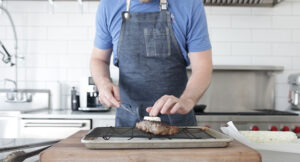This delicious steak recipe – Cold Sear Steak, from the school begins by placing the steak in a pan and heating it until a gorgeous brown sear forms ensuring a flawless cooking process. You’ll appreciate the simplicity of this method and how swiftly it cooks.
Every now and then we crave some beef. If you’re interested, in experimenting with steak dishes I recommend giving my Chopped Steak or Sous Vide Steak a try.
Cold Sear Steak
Cooks Illustrated has come up with a cooking method known as seared steak. This technique involves placing a steak, in a pan and gradually heating it up to heat before starting the searing process. The steak is flipped every two minutes to achieve a Maillard crust.
This method has benefits such, as reducing oil splatter outside the pan keeping the counter and stovetops clean and ensuring cooking through the flipping process. It’s an reliable technique that yields results particularly for those new, to cooking.
Ingredients and Substitutions
- Steak – The finest selections of steak include New York strip, ribeye, filet mignon, sirloin and flank steak.
- Seasoning – I seasoned the steak, with salt and freshly cracked pepper. It’s best not to use any steak rub or seasoning because it might burn during searing.
- Butter – I enjoy using maître d’ butter to top off my steaks, made with lemon, parsley, salt and pepper. For a kick try adding a splash of lemon juice along, with regular butter or flavored herb or garlic butter.
Equipment
- Nonstick or carbon steel skillet
- Kitchen thermometer
- Tongs or spatula
How to Cold Sear a Steak
Begin by patting the steak, on all sides using paper towels. Keep in mind that moisture can hinder the formation of a Maillard crust.
Place the steak on a rack, over a baking sheet and season both sides generously with salt.
Place the steak on the rack, in the fridge without covering it for 4 to 24 hours. This allows the salt to infuse into the steak enhancing its flavor with every bite. Moreover it aids in drying out the layer perfect, for a sear. This technique is commonly referred to as pre seasoning or dry brining a steak.
Take the steak out of the refrigerator sprinkle ground pepper on both sides and allow it to rest at room temperature for 10 minutes to take away the coldness.
Place the steak in “10 to 12” carbon steel or non stick pan with the side down. Turn up the heat to high and cook for two minutes. You might have to use tongs to keep it standing upright.
Place the steak flat. Allow it to sit for one minute. Next using tongs gently swirl the steak in a motion, for one minute. This method ensures browning of the side of the steak.
Flip the steak over and repeat the exact same process.
Lower the heat, to a setting turn the steak over periodically and allow it to cook for two minutes each time. Continue this routine at two minute intervals until reaching the desired level of doneness. Personally I aim for a texture, which typically requires about 12 to 14 minutes of cooking time for a thick steak measuring 1 ½ to 2 inches. For accuracy using a thermometer is recommended.
Take out the steak. Let it sit on a cooling rack placed over a baking sheet for about 5 to 7 minutes.
Finish by adding on optional herb butter.
Slice and serve the steak.
Make-Ahead and Storage
- Make-Ahead: This is meant to be eaten as soon as it is done cooking.
- How to Store: Cover and keep in the refrigerator for 3 days. This recipe will not freeze well.
- How to Reheat: This dish doesn’t taste as good when reheated. If you have to warm it up just pan sear it in hot oil with a hint of smokiness, until its heated through.
Chef Notes + Tips
- If you think you’ve cooked it for long try standing it up while letting it cool to help the heat dissipate faster.
- Leaving the steak for, over 24 hours can lead to it starting to dry out.
- The ideal pans, for searing a steak are non carbon steel.
- The Maillard reaction, commonly referred to as the process occurs when sugars and amino acids, in the steak react under heat between 285° and 350° resulting in a flavorful browning of the meat, with added crispness. It differs from caramelization.
- To cook steaks, at once make sure you have a pan that’s at least 12 inches, in size.
- I like my steak cooked rare so I take it out of the pan when it reaches, around 120° to 122° to allow for some cooking as it rests.

I spent a good bit of my 20’s touring the country playing music. As a teenager, and throughout my 20’s, in between music, I always worked in restaurants, in various capacities. Somewhere in my late 20’s I realized that I was not on the cover of Rolling Stone, as planned, and so, I started thinking about my future and trying to figure out other ways to have an impact, be creative and still live a bit of that rock ‘n roll lifestyle. The restaurant industry provided me with a good bit of those things. And so, I started honing my chops in the kitchen, putting my nose in food lover’s companion, and really started to go somewhere with it.
